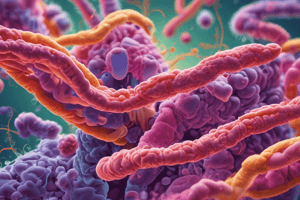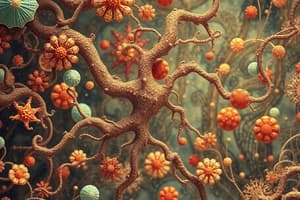Podcast
Questions and Answers
What is the primary energy production method used by anaerobic organisms?
What is the primary energy production method used by anaerobic organisms?
- Photorespiration
- Fermentation or anaerobic respiration (correct)
- Oxidative phosphorylation
- Aerobic respiration
Which of the following genera is NOT classified as a non-spore forming anaerobe?
Which of the following genera is NOT classified as a non-spore forming anaerobe?
- Clostridium (correct)
- Bacteroides
- Fusobacterium
- Peptostreptococcus
What is one potential effect of oxygen on anaerobic organisms?
What is one potential effect of oxygen on anaerobic organisms?
- It encourages spore formation
- It increases their metabolic rate
- It can kill or inhibit their growth (correct)
- It makes them more efficient at fermentation
Where are Bacteroides species predominantly found?
Where are Bacteroides species predominantly found?
Which characteristic differentiates anaerobic organisms from aerobic organisms?
Which characteristic differentiates anaerobic organisms from aerobic organisms?
Which of the following is a significant pathogen among Bacteroides species?
Which of the following is a significant pathogen among Bacteroides species?
What is the main causative organism of actinomycosis?
What is the main causative organism of actinomycosis?
What is the shape of Clostridium tetani spores as observed under a microscope?
What is the shape of Clostridium tetani spores as observed under a microscope?
In which environment are Clostridium species primarily found?
In which environment are Clostridium species primarily found?
Which culture medium is used to initially grow Clostridium tetani?
Which culture medium is used to initially grow Clostridium tetani?
Flashcards
Anaerobic organisms
Anaerobic organisms
Living things that can survive without oxygen.
Aerobic organisms
Aerobic organisms
Living things that need oxygen to survive.
Anaerobic respiration
Anaerobic respiration
Process where organisms make energy without oxygen.
Bacteroides species
Bacteroides species
Signup and view all the flashcards
Non-spore-forming anaerobes
Non-spore-forming anaerobes
Signup and view all the flashcards
Clostridium species
Clostridium species
Signup and view all the flashcards
Clostridium tetani
Clostridium tetani
Signup and view all the flashcards
Tetanus
Tetanus
Signup and view all the flashcards
Laboratory diagnosis of Cl. tetani
Laboratory diagnosis of Cl. tetani
Signup and view all the flashcards
Spore-forming anaerobes
Spore-forming anaerobes
Signup and view all the flashcards
Study Notes
Anaerobic Organisms: Spore and Non-Spore Formers
- Anaerobic organisms thrive in environments without oxygen, utilizing alternative energy pathways like fermentation or anaerobic respiration.
- They use electron acceptors other than oxygen.
- These organisms are found in various environments, including soil, water, and the human gut.
- Obligate anaerobes only grow in the complete absence of oxygen.
- Facultative anaerobes can grow in the presence or absence of oxygen.
- Microaerophilic organisms thrive in the presence of low amounts of oxygen.
- Aerotolerant anaerobes can tolerate oxygen but don't use it for respiration.
Oxygen Requirements of Bacteria
- Aerobes require oxygen for growth.
- Anaerobes cannot tolerate oxygen.
- Facultative anaerobes can grow with or without oxygen.
- Aerotolerant anaerobes can tolerate oxygen but don't use it for metabolism.
- Microaerophiles require small amounts of oxygen.
Differences Between Aerobic and Anaerobic Organisms
- Aerobes require oxygen for survival and energy production, using oxidative phosphorylation.
- Anaerobes do not require oxygen, using alternative methods like fermentation.
- Anaerobes can be inhibited or killed by oxygen.
Anaerobic Classification
- Anaerobic organisms are classified as spore-forming or non-spore-forming, and by Gram-positive or Gram-negative classification.
- Gram-negative bacilli: Bacteroides
- Gram-positive bacilli: Lactobacillus.
- Spore-forming anaerobes: Clostridium spp.
- Non-spore-forming anaerobes: Bacteroides, Fusobacterium, Peptostreptococcus.
Non-Spore Forming Anaerobes (e.g., Bacteroides)
- These bacteria are commonly found in the human gut.
- They are often associated with infections related to the digestive system.
Bacteroides Species
- Gram-negative, anaerobic bacteria in the human gut.
- Commonly commensal, playing a role in gut health.
- Some species can become opportunistic pathogens, causing infections.
Anaerobic Non-Spore Forming Gram Negative Bacilli (e.g, Bacteroides)
- Gram negative short bacilli, often non-motile, non-spore forming, are pleomorphic (varying shape/size) often with terminal or central swellings, sometimes with vacuoles.
- They are normal inhabitants of the bowel and vagina.
- Infections include intra-abdominal infections, postoperative wound infections, puerperal sepsis, periodontitis, and lung abscess.
Types of Gram-positive Anaerobic Bacteria (e.g., Lactobacillus)
- Gram-positive, non-motile, often arranged in chains.
- Found in the oral cavity, intestines, vagina, milk, and milk products.
- Acidogenic, aciduric, protecting low pH conditions.
- Used as probiotics.
- Dental Caries are often attributed to Lactobacilli.
Actinomyces
- Gram-positive, branching filamentous bacteria.
- Some species are anaerobic, while others are microaerophilic.
- Actinomyces israelii causes actinomycosis, an infection (abscess).
- They form masses that protrude.
Spore-Forming Anaerobes
- These bacteria produce dormant, highly resilient spores to survive harsh conditions.
- When conditions become favorable, spores germinate and produce new vegetative bacteria that potentially cause infection.
- Examples are Clostridium spp.
Anaerobic Gram-Positive Spore-Forming Bacilli (e.g, Clostridia)
- Gram-positive spore-forming anaerobic bacteria residing in intestinal tracts of animals, soil and/or water.
- Medically important Clostridia:
- C. tetani causing tetanus.
- C. perfringens causing gas gangrene and food poisoning.
Tetanus
- Causative organism: Clostridium tetani.
- Morphology: Gram-positive, anaerobic, non-motile bacillus.
- Characteristic spore morphology (drumstick shape)
- Found in soil and intestinal tracts, producing a neurotoxin responsible for tetanus.
- Diagnostic characteristics include drum-stick spore morphology, growing in cooked meat media, and producing thin films/swarming.
Laboratory Diagnosis of Clostridium
- Direct smear of wound exudate shows Gram-positive bacilli with drum-stick morphology.
- Culture on specialized media (Robertson cooked meat medium) followed by subculturing onto blood agar.
- Subsequent analysis often includes testing for hemolysis and motility.
- Other analysis may include determining the production of thin film/swarming and/or slowly liquefying gelatin in the colonies.
Specimen Collection and Transport
- Maintaining strict anaerobic conditions during collection and transport are crucial, to prevent oxygen exposure.
- Employ specialized transport media (e.g., GasPak jars).
- Prompt delivery of specimens is essential for accurate diagnosis.
- Properly prepared specimens (e.g., anaerobic blood culture bottles) should be used and be fresh.
Difficulties in Specimen Collection
- Anaerobic bacteria are sensitive to oxygen exposure.
- Special collection techniques and transport containers are needed to maintain a reduced oxygen environment within.
- Careful sampling techniques may be necessary to obtain deep tissue specimens without contaminating them.
Antimicrobial Resistance
- Anaerobic bacteria can develop resistance to antibiotics, becoming difficult to treat in clinical settings.
- Factors contributing to resistance include overuse/misuse of antibiotics, inherent genetic resistance properties in certain species, and antibiotic use in agriculture.
Studying That Suits You
Use AI to generate personalized quizzes and flashcards to suit your learning preferences.
Related Documents
Description
This quiz delves into the fascinating world of anaerobic organisms, including their oxygen requirements and differences from aerobic counterparts. Explore the characteristics of both spore and non-spore forming anaerobes and understand their unique survival strategies in various environments.




